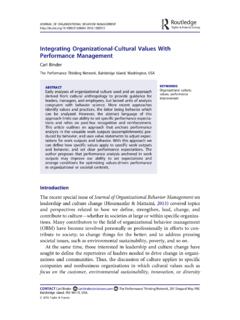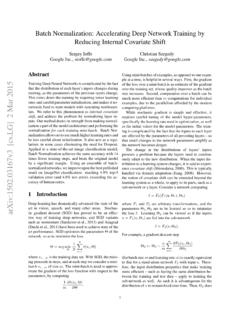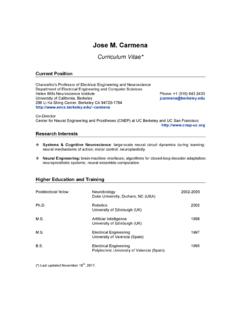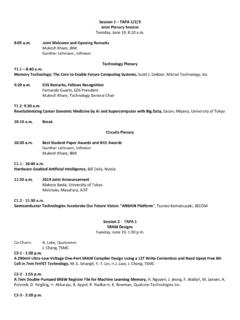Transcription of Six Boxes Whats So New R7
1 what s So New About The Six Boxes Model? A White Paper from The Performance Thinking Network Carl Binder, PhD, CPT 2005, 2009 This white paper answers the question posed in its title. After all, what is so new about The Six Boxes Model? Based on the long-respected, research-based Behavior Engineering Model originally formulated by Thomas F. Gilbert (1978), considered by many to be the Father of Human Performance Technology, this elegant framework for understanding and designing performance systems has been around for 30 years, or more. It represents the seed or essence of an understanding that exploded the field of programmed instruction (PI) into the much broader and more powerful field of human performance technology (HPT).
2 It has been used in one form or another by thousands (maybe tens of thousands) of performance improvement professionals and management consultants to analyze, problem-solve, design, and implement solutions for an enormous range of human performance challenges, from individual performance situations to entire organizations. Why bring it up again, when this model and its variants have been basic tools of so many for so long? Let me attempt to answer this very reasonable question. A Little History The answer to this question rests on a number of historical developments, and on the fruits of our decades-long mission to penetrate corporate and government organizations with a performance-based approach.
3 When Gilbert introduced the Behavior Engineering Model, it reflected an evolution of research-based methods in his community of consultants and researchers from an exclusive focus on the design of effective instruction to a wider perspective encompassing more variables. It had become clear that while effective training could have a significant impact on human performance, it seldom worked alone. In fact, when training was introduced into performance environments in which other behavior influences were lacking or in conflict, it was seldom cost-effective. As Gilbert and his peers examined the full scope of potential behavior influences, they realized that for performance to accelerate and maintain, it was necessary to manage a broader range of variables and conditions.
4 The story of this evolution is well-understood and documented ( , Dean, 1994; Stolovitch and Keeps, 1999). And the evolution itself gave rise to a change in the name of a professional association from the National Society for Programmed Instruction (NSPI) to the International Society for Performance Improvement (ISPI). It is important to recognize, however, that the Behavior Engineering Model and its variants, along with the myriad of algorithmic processes and methodologies that emerged with these models, were ..when training was introduced into environments in which other behavior influences were lacking or in conflict, it was seldom [It became clear that] for performance to accelerate and maintain, it was necessary to manage a broader range of variables and conditions.
5 2005, 2009 The Performance Thinking Network Bainbridge Island, WA USA 1 strictly in house tools. That is, while sophisticated performance improvement professionals took pride in their understanding and application of these models and methodologies, their relatively arcane terminology hindered wider communication and adoption by ordinary training, development, and business management professionals. The language was too academic, too technical, and certainly anything but intuitive. When introduced to the typical business or government manager, the model raised more questions than it clarified understanding.
6 It was not for the masses of the corporate or public sectors. During the early 1980 s, Binder joined the ranks of performance researchers and consultants using the Behavior Engineering Model, under the tutelage of Tom Gilbert. He became enthusiastic about its power and applied it to an increasingly broad set of situations, from needs analysis, to performance design, and implementation planning for training and management programs that required changes in the behavior of people in organizations. However, Binder and his associates were stymied by the lack of comprehension they encountered among their clients executives and managers who appreciated the effectiveness of the programs developed using Gilbert s model, but who expressed confusion or disinterest about the language of the model itself.
7 Thus began efforts to reformulate the model in a way that would allow more rapid comprehension and more frequent and immediate application by those to whom it was introduced. During the 1980 s Binder and his Associates tested and refined new language for describing each of the cells in Gilbert s original model as they worked with managers and executives, as documented in Binder s (1998) account of The Six Boxes Model. By the early 1990 s modifications in the language and simplification of the model had achieved its desired objective. By that time, introducing the model informally and in brief discussions to a wide range of individuals and groups typically resulted in immediate comprehension and application of the model in ways that delivered valuable outcomes to users.
8 It was not uncommon to find, months after an initial introduction, that the language of the new model had become part of the users working vocabularies. Often, graphic representations of the model were posted in cubicles and on bulletin boards as reminders of the factors to be considered in the analysis and design of performance systems. This was an important breakthrough, only partly appreciated at the time. Several years later, after introducing the new model (which we still called by a variety of fancy names) as a core element in training for a group of Performance Consultants at a major corporation Dun and Bradstreet we achieved the final clarification: it s new name.
9 Our client at the time, an experienced and wise sales executive, suggested we It was not uncommon to find, months after an initial introduction, that the language of the [Six Boxes ] model had become part of the users working vocabularies 2005, 2009 The Performance Thinking Network Bainbridge Island, WA USA 2 simply call it the six Boxes . We often referred to the different cells in the model as Boxes , so it made perfect sense to give the new model this simple, descriptive name. Our model, now formally named and trademarked as The Six Boxes Model, took yet another step when it became one of the core tools for training performance consultants and account managers at the sales and marketing consulting firm, Product Knowledge Systems, Inc.
10 We learned how easy it was to train consultants in use of the model and to help them teach clients how to use The Six Boxes in performance analysis, training support, program implementation, and a range of other applications. Now fully field-tested, The Six Boxes had become a solid and substantial performance improvement tool, easily accessible to clients and colleagues alike, and made public in Binder s (1998) account. Still, however, the Six Boxes was a tool in our toolbox, mostly hidden except to clients and consulting associates. We used it in virtually every project we conducted with clients, from executive alignment to detailed performance design; but we seldom talked very much about it, except as needed.






